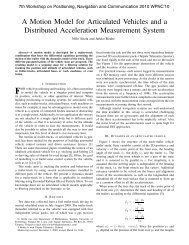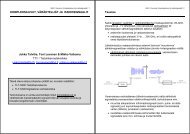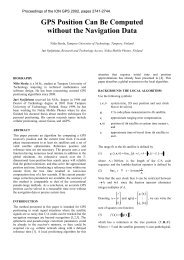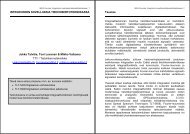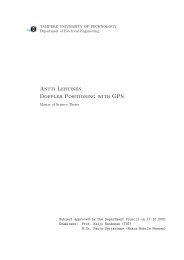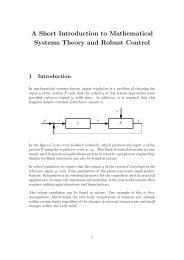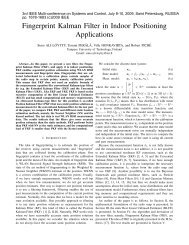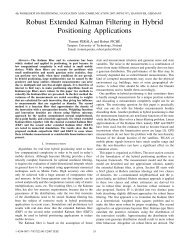mathematical model for single-pass crossflow heat exchanger
mathematical model for single-pass crossflow heat exchanger
mathematical model for single-pass crossflow heat exchanger
Create successful ePaper yourself
Turn your PDF publications into a flip-book with our unique Google optimized e-Paper software.
MATHEMATICAL MODEL FOR SINGLE-PASS<br />
CROSSFLOW HEAT EXCHANGER<br />
TIMO EIROLA, HELSINKI UNIVERSITY OF TECHNOLOGY<br />
JUKKA TUOMELA, UNIVERSITY OF JOENSUU<br />
KALLE RIIHIMÄKI, TM SYSTEM FINLAND OY<br />
MATTI HEILIÖ, LAPPEENRANTA UNIVERSITY OF TECHNOLOGY<br />
HEIKKI HAARIO, LAPPEENRANTA UNIVERSITY OF TECHNOLOGY<br />
Contents<br />
1. Introduction 1<br />
2. NTU-method Solution <strong>for</strong> Pure Crossflow Heat Exchanger<br />
Without Phase Change 2<br />
3. Differential equations 5<br />
4. Discretization 6<br />
5. Numerical results 7<br />
6. Conclusions 8<br />
List of Symbols 9<br />
References 9<br />
1. Introduction<br />
Basic idea of the <strong>heat</strong> <strong>exchanger</strong> is to transfer <strong>heat</strong> from the hot fluid flow to<br />
the cold one. This phenomenon can be done with many various equipment<br />
and in this report it is presented how to evaluate <strong>heat</strong> recovery process in<br />
the plate type <strong>heat</strong> echanger where <strong>heat</strong> is recovered from the hot air flow<br />
to the cold air. Flowsheet and key factors <strong>for</strong> this type of <strong>crossflow</strong> <strong>heat</strong><br />
<strong>exchanger</strong> is presented in figure 1.<br />
Physically plate <strong>exchanger</strong> is a set of metal plates, which separate hot and<br />
cold fluid flows from each other. General layout of the <strong>heat</strong> <strong>exchanger</strong>s is<br />
presented in figure 2.<br />
The basic system is the <strong>heat</strong> <strong>exchanger</strong> where all fluid flows remain in gas<br />
phase and no condensing occurs over the <strong>heat</strong> surfaces. This type of system<br />
can be defined with the basic energy equations. The special case is presented<br />
when the temperature of the <strong>heat</strong> surface decreases below the saturation<br />
temperature (dew-point) of the humid air. In this situation the vaporised<br />
water will condense and release its latent energy. To <strong>model</strong> this exchange<br />
process we need simultaneous <strong>model</strong>ling of energy and mass transfer.<br />
1
Figure 1. Flow sheet <strong>for</strong> the <strong>crossflow</strong> <strong>heat</strong> <strong>exchanger</strong><br />
Figure 2. Physical layout of the <strong>crossflow</strong> <strong>heat</strong> <strong>exchanger</strong><br />
2. NTU-method Solution <strong>for</strong> Pure Crossflow Heat Exchanger<br />
Without Phase Change<br />
The NTU-method (number of transfer units) is one of the traditional solution<br />
methods <strong>for</strong> the <strong>heat</strong> <strong>exchanger</strong> problems. The main limitation of this<br />
method is that it is difficult to handle <strong>heat</strong> <strong>exchanger</strong>s where <strong>heat</strong> transfer<br />
coefficient changes remarkably over the <strong>heat</strong> surface. However in this report<br />
the main target is to develop a sufficient <strong>model</strong> <strong>for</strong> dry surface <strong>heat</strong><br />
2
<strong>exchanger</strong> and NTU-solution is to be used as a reference point <strong>for</strong> the new<br />
solution method. The equations and routines <strong>for</strong> NTU-method are widely<br />
presented in many references like [Incropera 1990] and [VDI-Heat Atlas,<br />
1993] and method is described here only generally.<br />
The general assumptions <strong>for</strong> the problem solution are as follows:<br />
(1) All physical properties <strong>for</strong> incoming fluid flows are known.<br />
(2) Heat <strong>exchanger</strong> is insulated from its surroundings, in which case the<br />
only <strong>heat</strong> exchange is between hot and cold fluids.<br />
(3) Conduction along the walls is negligible.<br />
(4) Potential and kinetic energy changes are negligible.<br />
(5) Fluid is flowing only in one direction inside each <strong>heat</strong> <strong>exchanger</strong> tube<br />
or channel.<br />
(6) All fluids enter the <strong>heat</strong> <strong>exchanger</strong> with a uni<strong>for</strong>m velocity.<br />
(7) Overall <strong>heat</strong> transfer coefficient changes over the <strong>heat</strong> surfaces are<br />
negligible.<br />
When there is no condensation or evaporation on the <strong>heat</strong> surfaces the total<br />
<strong>heat</strong> transfer rate of the cross-flow <strong>heat</strong> <strong>exchanger</strong> can be calculated with<br />
the equation<br />
(1)<br />
where<br />
Φ = µf∆TlnAtot,<br />
Φ <strong>heat</strong> transfer rate [W]<br />
f correction factor to fix the error got from the assumption [-]<br />
<strong>for</strong> the log-mean-temperature<br />
µ overall <strong>heat</strong> transfer coefficient [W/m 2 K]<br />
∆Tln log mean temperature difference computed under [K]<br />
the assumption of counter-flow conditions<br />
Atot Total effective <strong>heat</strong> surface area [m 2 ]<br />
Log mean temperature difference can be calculated<br />
(2)<br />
∆Tln = ∆T1 − ∆T2<br />
ln ∆T1<br />
∆T2<br />
∆T1 = Tin − ˜ Tout<br />
∆T2 = Tout − ˜ Tin<br />
The overall <strong>heat</strong> transfer coefficient <strong>for</strong> the <strong>heat</strong> <strong>exchanger</strong> is defined:<br />
(3) µ =<br />
where<br />
1<br />
1 s 1 + hcold λ + hhot<br />
3
hcold convection coefficient between cold fluid flow and [W/m 2 K]<br />
<strong>heat</strong> surface<br />
hhot convection coefficient between hot fluid flow and [W/m 2 K]<br />
<strong>heat</strong> surface<br />
s thickness of the <strong>heat</strong> exhanger wall [m]<br />
λ conductivity of the <strong>heat</strong> exhanger wall [W/mK]<br />
The correction factor f can be either checked from the dimensioning diagrams<br />
<strong>for</strong> the pure cross-flow <strong>heat</strong> <strong>exchanger</strong> (See figure 3) or to be calculated<br />
with the equations presented in [VDI Heat Atlas, p. Ca 7-9].<br />
Figure 3. Dimensioning diagram <strong>for</strong> the pure <strong>crossflow</strong> <strong>heat</strong><br />
<strong>exchanger</strong> [VDI Heat Atlas, p. Ca 25]<br />
The dimensioning base <strong>for</strong> the sample system is:<br />
qm,cold = 24, 3 kg/s<br />
Tcold,in = 30 o C<br />
xcold = 20 g/kg<br />
qm,hot = 28, 0 kg/s<br />
Tcold,in = 85 o C<br />
xcold = 160 g/kg<br />
Physical dimensions of the <strong>heat</strong> <strong>exchanger</strong> are presented in figure 4.<br />
The convection coefficients are calculated with the correlations developed<br />
<strong>for</strong> the <strong>for</strong>ced convection over the vertical plate [Incropera, Chapter 7.2].<br />
4
Figure 4. Sample <strong>heat</strong> <strong>exchanger</strong><br />
Calculated values <strong>for</strong> the current <strong>exchanger</strong> and operating conditions are:<br />
hcold = 56.6 W/m 2 K<br />
hhot = 42.9 W/m 2 K<br />
λ = 20 W/mK<br />
s = 0.5 · 10 −3 m<br />
⇒ µ = 24, 3 W/m 2 K<br />
The total <strong>heat</strong> surface area <strong>for</strong> the current configuration is 816 m 2 .<br />
Using equation (1) and solving it iteratively we get the results:<br />
Tcold,out = 55, 2 o C<br />
Thot,out = 67, 8 o C<br />
f = 0.953<br />
⇒ Φ = 636, 6 kW<br />
3. Differential equations<br />
Here we develop a numerical scheme based directly on the differential equations<br />
govering the <strong>heat</strong> flows. In this case both fluid flows are assumed to<br />
remain under the non-condensing conditions and due to that mass transfer<br />
is not to be <strong>model</strong>led.<br />
5
Consider first the differential equations of two dimensional <strong>heat</strong> conduction<br />
in two domains below and above the plate separating the air flows<br />
(4)<br />
ut = α∆ u − 〈v, ∇u〉 − µ (u − ũ) ,<br />
ũt = ˜α∆ ũ − 〈˜v, ∇ũ〉 − ˜µ (ũ − u) .<br />
Here u (ũ) is the temperature of the cold (hot) air, and v , ˜v are the<br />
velocities of the flow. In the case of cross flows we take v = (vc, 0) , ˜v =<br />
(0, vh) .<br />
When the velocities are large and temperature differences significant, we can<br />
omit the horizontal diffusion, i.e., set α = ˜α = 0 . Then at the equilibrium<br />
we have<br />
vc ux(x, y) + µ (u(x, y) − ũ(x, y)) = 0 ,<br />
(5)<br />
vh ũy(x, y) + ˜µ (ũ(x, y) − u(x, y)) = 0 ,<br />
in the domain (x, y) ∈ (0, Lx) × (0, Ly) .<br />
Further, the inflow temperatures are constants, so we have the boundary<br />
conditions<br />
u(0, y) = Tc , ũ(x, 0) = Th .<br />
The velocities v, ˜v represent the <strong>heat</strong> capacity rates <strong>for</strong> the flows divided<br />
evenly over the <strong>heat</strong> exhanger plate surfaces. Factor µ is overall <strong>heat</strong> transfer<br />
coefficient calculated according to the equation (3).<br />
Note<br />
Since u(0, y) = Tc is known, we can solve<br />
˜µ<br />
− y v ũ(0, y) = e h Th + ˜µ<br />
vh<br />
y<br />
0<br />
˜µ<br />
− (y−ξ) v e h u(0, ξ) dξ .<br />
Then we find easily the dew point ( ũ(0, ydew) = Tdew ) on the x = 0 –<br />
boundary:<br />
ydew = vh<br />
˜µ ln<br />
<br />
Th −<br />
<br />
Tc<br />
.<br />
Tdew − Tc<br />
Similarly, since ũ(x, 0) is known, we could solve u(x, 0) explicitly.<br />
4. Discretization<br />
Inside the rectangle we consider numerical approximation in a uni<strong>for</strong>m grid<br />
consisting of points (i hx, j hy) , i = 0, 1, . . . , m , j = 0, 1, . . . , n , where<br />
hx = Lx/m , hy = Ly/n .<br />
Let us denote ui,j ≈ u(i hx, j hy) and similarly <strong>for</strong> ũ . Using central differences<br />
and averages at ( (i + 1<br />
2 ) hx , j hy ) and ( i hx , (j + 1<br />
2 ) hy ) we get the<br />
equations<br />
(6)<br />
ui+1,j − ui,j<br />
vc<br />
hx<br />
ũi,j+1 − ũi,j<br />
vh<br />
hy<br />
<br />
ui+1,j + ui,j<br />
+ µ<br />
2<br />
<br />
ũi,j+1 + ũi,j<br />
+ ˜µ<br />
2<br />
6<br />
− ũi+1,j +<br />
<br />
ũi,j<br />
= 0 ,<br />
2<br />
− ui,j+1 + ui,j<br />
2<br />
<br />
= 0 .
At the inflow boundaries we extrapolate: ũ( 1<br />
2hx, jhy) ≈ 3<br />
2 ũ1,j − 1<br />
2 ũ2,j and<br />
u(ihx, 1<br />
2hy) ≈ 3<br />
2 ui,1 − 1<br />
2 ui,2 . Another option would be to use the explicit<br />
solutions <strong>for</strong> ũ(0, y) and u(x, 0) (see the note above) in the averages.<br />
Matrix <strong>for</strong>m<br />
Let us write the unknowns into m × n matrices: U = [ui,j] , Ũ = [ũi,j] .<br />
Then we get<br />
(7)<br />
where<br />
⎡<br />
Dx = ⎣<br />
vc µ<br />
vc Dx U + µ Mx U − µ Ex Ũ = ( − hx 2 ) Tc Jx ,<br />
vh Ũ DT y + ˜µ Ũ M T y − ˜µ U E T y = ( vh ˜µ<br />
− hy 2 ) Th J T y ,<br />
1<br />
−1 1<br />
. .. . ..<br />
−1 1<br />
⎤<br />
⎦ , Mx =<br />
⎡<br />
⎢<br />
⎣<br />
1<br />
2<br />
1<br />
2<br />
1<br />
2<br />
. .. . ..<br />
1<br />
2<br />
1<br />
2<br />
⎤<br />
⎥<br />
⎦ , Ex =<br />
⎡<br />
3 1<br />
− 2 2<br />
1 1<br />
2 2<br />
. .. . ..<br />
1 1<br />
2 2<br />
⎢<br />
⎣<br />
⎤<br />
⎥<br />
⎦ ,<br />
and Jx has ones on the first row, otherwise it is zero. Dy, My, Ey, Jy are<br />
obtained similarly (but they may be of different size).<br />
Vector <strong>for</strong>m<br />
Now, write the unknowns in long vectors: u = ⎣<br />
.<br />
⎦ , ũ = ⎣<br />
.<br />
⎦ , i.e.,<br />
um,n<br />
ũm,n<br />
the columns of U (respectively Ũ ) on top of each other. Then we get the<br />
linear system<br />
<br />
u<br />
A = b ,<br />
ũ<br />
where<br />
A =<br />
⎡<br />
u1,1<br />
u2,1<br />
I ⊗ (vc Dx + µ Mx) −µ I ⊗ Ex<br />
−˜µ Ey ⊗ I (vh Dy + ˜µ My) ⊗ I<br />
and b is obtained by organizing the right hand sides of (7) accordingly.<br />
In matlab we set these up as sparse matrices using kron <strong>for</strong> the Kronecker<br />
product ⊗ . Then we use the direct sparse solver.<br />
5. Numerical results<br />
We apply the equations above with the same parameter values as in earlier<br />
solution with the NTU-method.<br />
Tc = 30 o C, Lx = 4, vc = 121.4, m = 60, hx = 1<br />
15 ,<br />
Th = 85 o C, Ly = 2, vh = 90.6, n = 40, hy = 1<br />
20 .<br />
7<br />
⎤<br />
<br />
⎡<br />
,<br />
ũ1,1<br />
ũ2,1<br />
⎤
The overall <strong>heat</strong> transfer coefficient is µ = ˜µ=24.3 W/m 2 K.<br />
Figure 5 shows the temperature profiles in the equilibrium solved with the<br />
above listed parameters.<br />
80<br />
70<br />
60<br />
50<br />
40<br />
30<br />
2<br />
1.5<br />
1<br />
0.5<br />
0<br />
Figure 5. Temperature <strong>for</strong> the hot and cold air stream<br />
across the <strong>heat</strong> <strong>exchanger</strong> slot<br />
At the outflow boundaries we get the following average temperatures, which<br />
can be compared with the temperatures got from NTU-solution with the<br />
assumption of counter-flow conditions:<br />
Tcold,out = 55, 5 o C<br />
Thot,out = 67, 9 o C<br />
The power of the <strong>heat</strong> <strong>exchanger</strong> is Φ = 632.3 kW.<br />
6. Conclusions<br />
The <strong>model</strong> <strong>for</strong> cross-flow <strong>heat</strong> <strong>exchanger</strong> was developed and the results<br />
were compared with the results calculated with the traditional dimensioning<br />
method (NTU). The results were as follows:<br />
Parameter NTU-method Developed method<br />
Tcold,out 55.2 o C 55.5 o C<br />
Thot,out 67.8 o C 67.9 o C<br />
Φ 636.6 kW 632.2 kW<br />
8<br />
0<br />
1<br />
2<br />
3<br />
4
As seen above the <strong>model</strong> seems to work well under the specified operation<br />
conditions.<br />
The future actions to develop the <strong>model</strong> further is to focuse on the following<br />
areas:<br />
(1) Additional test runs <strong>for</strong> different <strong>heat</strong> <strong>exchanger</strong> geometries<br />
(2) Modelling of the material and fluid properties<br />
(3) Heat and mass transfer <strong>model</strong> <strong>for</strong> the condensing conditions<br />
(4) Model <strong>for</strong> the multi-<strong>pass</strong> <strong>heat</strong> <strong>exchanger</strong> configuration<br />
List of Symbols<br />
Symbols<br />
f correction factor to fix the error got from [-]<br />
the assumption of counter-flow temperatures<br />
h convection <strong>heat</strong> transfer coefficient [W/m 2 K]<br />
q flow [unit/s]<br />
s thickness [m]<br />
v velocity, <strong>heat</strong> capacity rate [J/Ks]<br />
x absolute water content of the air [kg/kg]<br />
Atot total effective <strong>heat</strong> surface area [m 2 ]<br />
T Temperature [K]<br />
∆Tln log mean temperature difference [K]<br />
λ conductivity [W/mK]<br />
µ overall <strong>heat</strong> transfer coefficient [W/m 2 K]<br />
Φ power [W]<br />
1, 2 indices [—]<br />
Subscripts<br />
c, cold cold fluid flow [-]<br />
m mass [kg]<br />
˜, h, hot hot fluid flow [-]<br />
References<br />
Incropera, Frank P. & DeWitt, David P., 1990. Fundamentals of Heat and<br />
Mass Transfer. 3. p. Indiana. John Wiley & Sons.<br />
VDI-Heat Atlas, 1993. 6.p. Düsseldorf. VDI-Verlag GmbH.<br />
9




